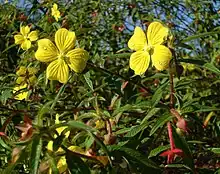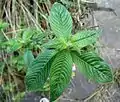Ludwigia octovalvis
Ludwigia octovalvis is a species of flowering plant in the Onagraceae family known by the common name Mexican primrose-willow.[1] Its native distribution is unclear, but can be found in Central America, Australia, South-East Asia, Tamilnadu (IND), the Middle East, the Central-West African regions and spreads easily to become naturalized.[2] It is also cultivated as an aquatic plant.[3] The plant is known for its anti-aging properties.[4] The species is sometimes regarded as an invasive species[5] and is classified by IUCN as of Least Concern with stable populations.[6] An adult plant is one meter tall on average but is able to grow taller.[7] It spreads to form mats on the mud, rooting at nodes in contact with the substrate, or floats ascending in the water. Its flowers are yellow in appearance. They are made up of green and red stems.[8] They yield small capsular fruits containing many minute seeds.
| Ludwigia octovalvis | |
|---|---|
 | |
| Scientific classification | |
| Kingdom: | Plantae |
| Clade: | Tracheophytes |
| Clade: | Angiosperms |
| Clade: | Eudicots |
| Clade: | Rosids |
| Order: | Myrtales |
| Family: | Onagraceae |
| Genus: | Ludwigia |
| Species: | L. octovalvis |
| Binomial name | |
| Ludwigia octovalvis (Jacq.) P.H.Raven | |
Gallery
References
- USDA, NRCS (n.d.). "Ludwigia octovalvis". The PLANTS Database (plants.usda.gov). Greensboro, North Carolina: National Plant Data Team. Retrieved 2 October 2015.
- Ludwigia octovalvis from the Invasive Species Compemdium
- Wu, SJ; Ng, LT; Wang, GH; Huang, YJ; Chen, JL; Sun, FM (2010). "Chlorophyll a, an active anti-proliferative compound of Ludwigia octovalvis, activates the CD95 (APO-1/CD95) system and AMPK pathway in 3T3-L1 cells". Food Chem. Toxicol. 48 (2): 716–21. doi:10.1016/j.fct.2009.12.001. PMID 19963029.
- Lin, WS; Chen, JY; Wang, JC; Chen, LY; Lin, CH; Hsieh, TR; Wang, MF; Fu, TF; Wang, PY (2014). "The anti-aging effects of Ludwigia octovalvis on Drosophila melanogaster and SAMP8 mice". Age (Dordr). 36 (2): 689–703. doi:10.1007/s11357-013-9606-z. PMC 4039272. PMID 24338263.
- US National Library of Medicine - Institute of Health
- IUCN Redlist: Ludwigia octovalvis
- JCU: Discover nature
- "Florida Wildflower Cooperative: Ludwigia octovalvis". Archived from the original on 2015-11-03. Retrieved 2015-10-02.
External links
- Australian Tropical Rainforess Plants: Ludwigia octovalvis
- Discover Nature: Ludwigia octovalvis
- Lin, WS; Chen, JY; Wang, JC; Chen, LY; Lin, CH; Hsieh, TR; Wang, MF; Fu, TF; Wang, PY (2014). "The anti-aging effects of Ludwigia octovalvis on Drosophila melanogaster and SAMP8 mice". Age (Dordr). 36 (2): 689–703. doi:10.1007/s11357-013-9606-z. PMC 4039272. PMID 24338263.



_-_Flower.jpg.webp)
_-_Flower_and_leaves.jpg.webp)